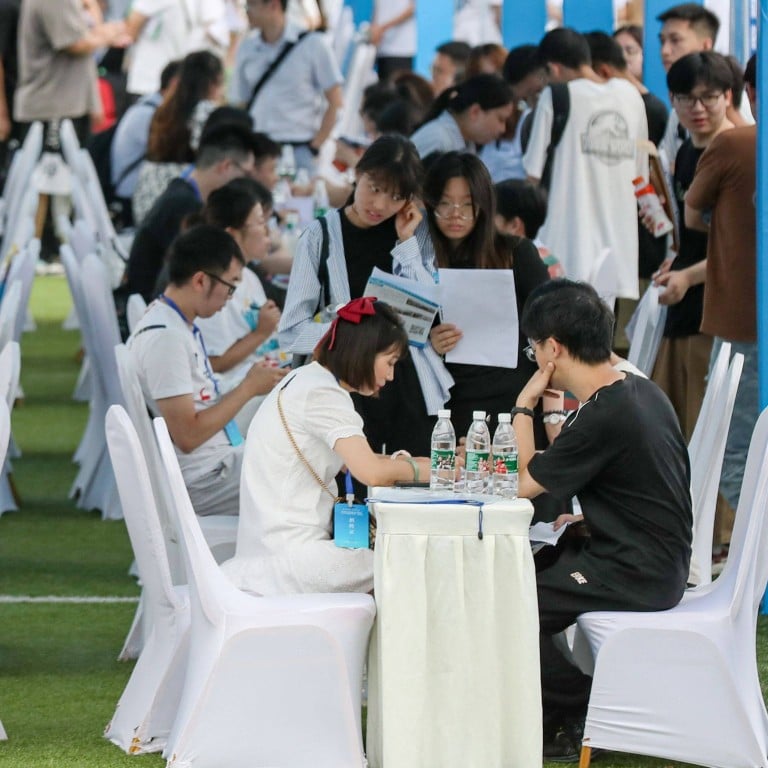
China’s private sector struggles as economic growth falters in May, youth unemployment hits new high
- Fixed-asset investment from private business fell by 0.1 per cent in the first five months of the year, while inflows of foreign direct investment dropped by 5.6 per cent
- Industrial output from private firms also grew by only 0.7 per cent last month, while the jobless rate for the 16-24 age group also hit a record high in May
China’s private sector, the biggest source of jobs for its 1.4 billion people, continued to struggle last month despite Beijing’s push for a post-coronavirus economic recovery, partly explaining the record-high youth unemployment and calls for more action to boost investor confidence.
The weakness of both industrial output and investment from the private sector, which employs more than 80 per cent of urban workforce, stood out among the across-the-board slowing of economic activities in May, according to data released by the National Bureau of Statistics (NBS) on Thursday.
Overall fixed-asset investment rose by 4 per cent in the first five months of 2023, year on year, down from a rise of 4.7 per cent in the first four months.
But fixed-asset investment from private business fell by 0.1 per cent, down from the 0.4 per cent rise in the first four months, and in sharp contrast with growth of 8.4 per cent seen by state-owned enterprises from January to May.
Zhao Xijun, a finance professor at Renmin University in Beijing, said the decline directly reflected the level of confidence that the private sector has in China’s economic recovery.
“Boosting retail sales is the way to restore market confidence and to tackle the problem of unemployment,” Zhao said.
Retail sales in May missed expectations and rose by 12.7 per cent, down from the 18.4 per cent increase in April.
The central government has not experienced these challenges before, the mindset for running the economy is still more or less stuck in the past
“Why couldn’t the central government also give spending incentives to the consumer side? For example lowering the income tax … issuing consumption vouchers is another direct way,” Zhao added, pointing to the stimulus that so far has only been focused on supporting enterprises.
“China has not gone through an economic downturn in the past. The central government has not experienced these challenges before, the mindset for running the economy is still more or less stuck in the past.”
One of China’s main challenges is its rising youth employment rate, but NBS spokesman Fu Linghui claimed that “some people have been misunderstanding the overall volume of our numbers”.
He noted that only 33 million of the 96 million people in the 16-24 age group are currently in a position to be employed, as many are students. And among those 33 million, he said, only around a fifth have been unable to find work.
In other data released on Thursday, industrial output from private firms grew by only 0.7 per cent last month, much lower than the 4.4 per cent rise reported by state-owned enterprises and the overall 3.5 per cent increase.
Investment in the property sector, meanwhile, fell by 7.2 per cent in the first five months of the year, down from a fall of 6.2 per cent in the first four months.
Further clouding China’s economic recovery prospects, inflows of foreign direct investment dropped by 5.6 per cent in the first five months of the year to US$84.35 billion, with the pace of decline deepening from the fall of 3.3 per cent in the first four months, according to the Ministry of Commerce.
“All data points so far send consistent signals that the economic momentum is weakening,” said Zhang Zhiwei, chief economist at Pinpoint Asset Management.
“To make the economic recovery sustainable, a significant boost from government policies seems necessary.”
Will AI be China’s ace in the hole to surpass the US and become the top economy?
China’s weakening economic performance has pushed the central bank to cut interest rates three times this week, while the US Federal Reserve paused its rate increases for the first time since March 2022.
“Amid the continued contraction in the land sales revenues of local governments, we expect Beijing to add an extra issuance quota of 500 billion yuan (US$70 billion) to local government special bonds,” the Nomura economists added.
“We believe Beijing will eventually have to play the role of the borrower and spender of last resort by stepping up funding for [state-owned enterprises] and local governments via policy banks, the PBOC’s various lending facilities, a larger bond financing quota and even an issuance of special central government bonds.”
Additional reporting by Mia Nulimaimaiti


